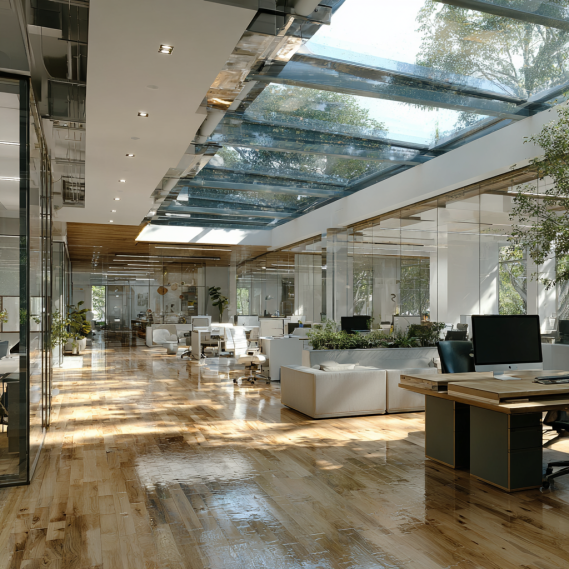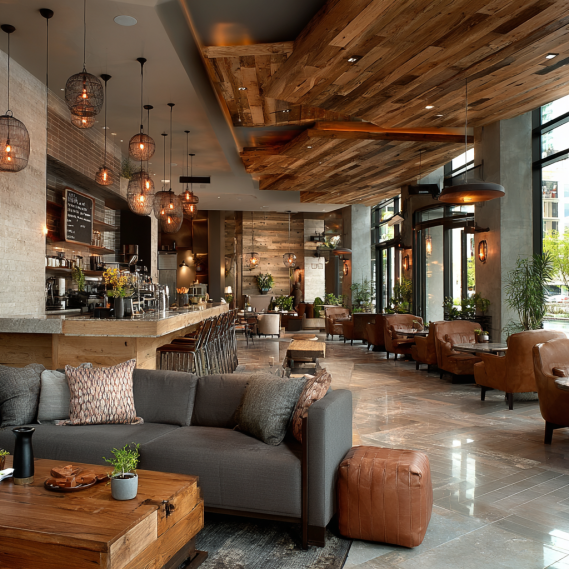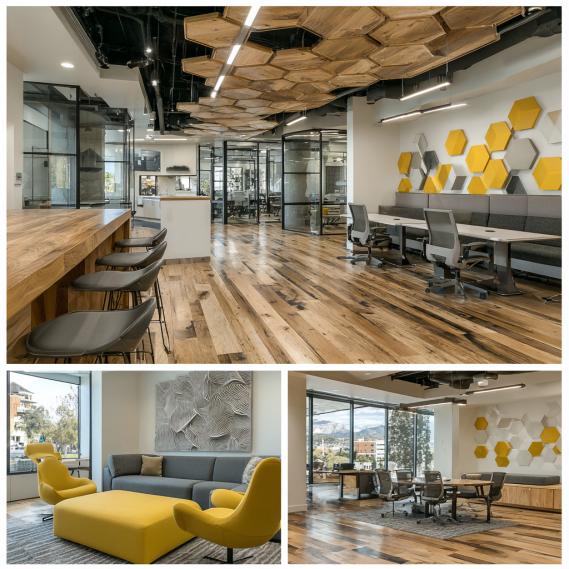
Why Commercial Interior Design Matters for Business: A California-Focused Guide
Smart commercial interior design isn’t just about aesthetics—it’s a strategic business lever. In California, where energy codes, green standards, and customer expectations are high, interior design for commercial spaces directly influences revenue, operating costs, compliance, employee performance, and brand perception. This guide breaks down why commercial interior design is crucial, supported by verified California data, real-world examples, and practical tips for office interior design, retail, hospitality, and more.
It can lift sales and service outcomes (yes, measurably)
Daylight isn’t just pleasant—it’s profitable. Several California studies led by Heschong Mahone Group found a strong association between daylight and retail sales, showing that skylit stores could increase sales by up to 40% chain-wide if skylights were adopted across all locations. Later research across 73 California stores reinforced this daylight-sales link at a smaller, but still significant, magnitude.
Why it matters for you (retail & hospitality):
- Prioritize useful daylight hours with diffusing skylights, clerestories, and glare control.
- Pair daylight with clean sightlines, merchandising lighting, and intuitive customer flows to amplify the effect.

Maximize Your Business Performance with Expert Commercial Interior Design
Create an environment that boosts productivity, enhances customer satisfaction, and supports your brand’s growth. Learn how commercial interior design in California can transform your space.
It boosts productivity and the quality of work
In commercial office design, access to windows, views, and daylight correlates with better worker performance. Research from Heschong et al. documented significant performance gains associated with daylight and view in office environments. Gensler’s Global Workplace Study echoes this, reporting that employees are still most productive in offices that support multiple work modes (focus, collaboration, social).
Design moves that matter (offices):
- Balance open collaboration with enclosed focus rooms and phone booths.
- Provide high-CRI lighting, glare control, and daylight access.
- Engineer acoustics (NRC ceiling panels, wall absorbers) to reduce noise complaints.
It slashes energy use and operating costs in California
California’s Title 24 Building Energy Efficiency Standards require robust lighting controls (occupancy, time-switch, partial-on/off, and daylight controls) in nonresidential spaces. When designed effectively, these systems reduce energy bills automatically by turning off or dimming lighting in empty zones while keeping the space comfortable.
Lighting Control Types:
- Occupant sensing / vacancy: Turns lights off when unoccupied.
- Automatic time-switch: Schedules lighting shut-off.
- Daylight-responsive: Dims/lifts lights based on available daylight.
California Basis: Title 24 nonresidential shut-off controls factsheet (CEC)
| Control Type | What It Does | California Basis |
|---|---|---|
| Occupant sensing / vacancy | Turns lights off when unoccupied | Title 24 nonresidential shut-off controls factsheet (CEC) |
| Automatic time-switch | Schedules lighting shut-off | Title 24 guidance (CEC / industry explainer) |
| Daylight responsive | Dims/lifts lights based on available daylight | Title 24 daylight control requirements |
It keeps you compliant and safer by design
California is a leader in green and health-forward codes. The California Green Building Standards Code (CALGreen) sets mandatory nonresidential measures that design teams must satisfy, including low-emitting materials, construction waste reduction, and indoor environmental quality. Addressing these early ensures compliance, avoids redesigns, and minimizes inspection delays.
Compliance highlights to build into your interiors scope:
- Low-VOC interior finishes and adhesives per CALGreen nonresidential mandatory measures.
- Documented waste management for construction/demolition.
- Lighting controls and power density aligned with Title 24, coordinate with the ceiling/MEP plan.
Accessibility obligations also shape interior planning (clearances, restrooms, signage). Staying aligned with California access regulations reduces risk and rework.

Transform Your Commercial Space with Professional Design in CA
Whether it’s for your office, retail, or restaurant, commercial interior design in California is the key to a functional, stylish, and efficient space. Ready to upgrade your business environment?
It Elevates the Customer Experience (and Revenue Mix)
A well-designed environment drives dwell time, customer spend, and loyalty. California offers standout examples like San Francisco International Airport (SFO), where the overhaul of Harvey Milk Terminal 1 with daylight, calming volumes, and hospitality-driven amenities enhanced the passenger experience and boosted revenue from concessions.
What you can learn from SFO for retail/hospitality:
- Lead with a clear first impression (entry sequence, lighting, material warmth).
- Design for intuitive wayfinding and inclusive amenities (sensory rooms, quiet spaces).
- Use local brand integration (F&B, shops) to deepen connection and spend.
It strengthens brand and hiring power
Commercial interior design is a 3D brand touchpoint. In competitive California markets, consistent material language, graphics, and lighting create trust—whether you’re a bank communicating stability or a startup signaling innovation. Research shows that employees value well-designed office environments to perform their best. Translating your brand into office interior styles that support focus, team rituals, and social interactions boosts employee attraction and retention.
It improves health and indoor environmental quality
California’s codes push for low-emitting materials and better air quality. Designers can go further with biophilic elements, view corridors, and acoustic control, measures proven to reduce stress and improve cognitive function. Legacy research in California underscores the link between daylight and human performance.
| Business Outcome | Design Lever | California Angle / Evidence |
|---|---|---|
| Higher sales | Daylight, clear layouts, lighting that supports merchandising | Daylight–sales associations in CA retail studies; skylight scenario up to 40% chain-wide sales potential in modeling. |
| Better productivity | Daylight/views, acoustics, task–collab balance | Office performance linked to windows/daylight; workplace design that supports varied modes. |
| Lower energy bills | Title 24 lighting controls; daylight harvesting | Mandatory shut-off/daylight controls reduce run hours by design. |
| Fewer change orders | Early code & access coordination; CALGreen materials | Bake CALGreen + Title 24 into DD/CDs; align specs with inspections. |
| Customer loyalty | Hospitality-style experience, intuitive wayfinding | SFO’s passenger-experience upgrades praised; revenue from concessions rises with better UX. |
ROI in Practice: Where the Value Shows Up
A well-designed commercial space directly impacts business performance. Designing with purpose leads to measurable improvements in sales, employee productivity, and customer engagement. Here’s how to ensure your commercial space drives results in California:
Design Checklist for California Projects:
- Define KPIs: Sales per sq. ft., dwell time, throughput.
- Map user journeys: First-time visitor legibility, staff flows.
- Confirm occupancy type, Title 24 lighting approach, and CALGreen requirements.
- Target useful daylight, pair with daylight-responsive dimming.
- Specify low-VOC paints, adhesives, sealants; document submittals for inspections.
- Provide absorption (NRC ceilings) and contract-grade seating for employee comfort.
Commercial Design That Works for Your Business
From office layouts to retail spaces, commercial interior design in California can optimize performance, enhance branding, and create memorable customer experiences. Whether you’re designing a customer-centric store, a high-performing office, or a hospitality space, the right design will align with your goals and boost your ROI.
Conclusion
Commercial interior design is a strategic investment for any business in California. It’s more than just aesthetics—it’s about improving your space’s functionality, efficiency, and overall performance. Whether enhancing sales, boosting productivity, or creating a better customer experience, commercial design drives measurable results. Ready to transform your space? Let’s get started today!

Unlock Business Growth with Commercial Interior Designers in CA
Explore how the right design can improve employee performance, enhance customer experience, and drive sales. Commercial interior design in California is a smart investment for your business.





